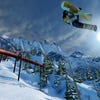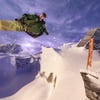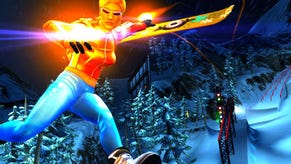SSX Review
Go to the mountain.
SSX's lead characters are absent from the first 15 minutes of the game. You meet them soon enough - resolute, ancient, snow-capped behemoths plucked from the Rockies, Alps and Himalayas, drawn up through a NASA satellite and digitally deposited into the game - but before you can walk them, you must first learn how to fly above them.
Dropped from a helicopter at 30,000 feet, the opening minutes of SSX give everybody the chance to experience the game's true quest object: flow. Freefalling through the sky with no trees to slam against, no rails to miss, no snow tundra to upset the carve of your combo, you are free to chain trick after trick and watch the score counter climb to the stratosphere. 20 hours later and there's a chance you'll be able to link trick to tweaked trick with this kind of uninterrupted elegance, but for now you can wax lyrical with your thumbs without fear of stutter.
Then, when you've mastered the basic vocabulary, it's time to meet the opponent against whom you're going to pit it. A squeeze of the right bumper and you open a wing suit, gliding to the ground where miles of snow dip and rise. Rock protrusions provide rails, and ice sheets scream you into tunnels that burrow through the earth before spitting you out into twirling drops.
For all the wonder of limitless combos in the sky, it's only when the first mountain turns up, along with its potential for disheartening failure or thrilling mastery, that joy truly avalanches through you. William Blake was right: great things are done when men and mountains meet.
It would be easy to dismiss the satellite technology that went into designing the game's 150-odd courses as a mere gimmick. And make no mistake, while the Aster Global Digital Elevation Map technology provided the blueprint of realism for these mountains, shaving months of grunt work off the project, the fingerprints of EA Canada's game designers are all over the peaks, adding jumps, drops and tunnels to increase the pace and excitement. Nevertheless, there's the sniff of truth to environments which, beneath the wind and the blizzards, enjoy a sense of place that's new to the SSX lineage.
Realism is not the word you'd use when it comes to the manner in which you fling yourself down the mountains, however. There are, of course, the physics-defying (and often spine-defying) tricks that can be strung together in quick succession over even the slightest of jumps. Mash the buttons and your boarder becomes a well-wrapped contortionist, striking poses as the combo counter tricks together in the bottom left corner of the screen.
Hold the left trigger as you land on a low-slung wall, following a 1080 degree spin, and you'll effortlessly grind along it, building meter that can be spent on a speed boost to rocket-propel you into the sky. Hold down the X or B button and you can maintain combos by grinding along snow, the potential there to combo the entire run (while, of course, risking your mounting score total, which is only "cashed" when you add a full stop to your string of tricks).
Realism is shooed further away as EA Canada's designers pull all kinds of tricks of their own as they work to ensure you have the most fluid and stress-free journey down the slope. Land a jump just in front of a tree, for example, and the game will gently nudge you around the obstacle, constantly evaluating your lines and helping out in order to give you the best chance at finding flow. Normally such trickery would be a sign of weak design, but in SSX's case it's a welcome effort; it reduces the number of staccato starts while leaving the focal business of score-attack mostly untouched.
Of course, rarely does a run go perfectly. The breakneck physics of your character combined with the riotous terrain ensures that, for every time you land a jump with a boastful puff of snow, there is a time when you splang, arms waving, into a forgotten ravine. For these moments, the game offers a rewind function, allowing you to wind back the clock on the previous few seconds of play to rewrite your mistakes.
Every second of footage you undo incurs a points penalty, while in some events there's a limit on the number of times you may do this. Nevertheless, it's useful for when you just miss the rail you needed to maintain the combo, although for more serious falls, it's often just as sensible to restart the entire run.
EA has done more than simply pick out a set of licensed music tracks to give the experience a contemporary aural sheen. Rather, the tracks themselves ebb and flow with your rise and fall down the mountain. As you gain altitude from jumping from a snow ramp, the music fades and phazes before exploding back in full volume the second your board touches terra firma again; in the case of the dubstep and drum and bass tracks, providing a literal drop to accompany the music. The effect cannot be overstated, lending each playthrough a choreographed feel, as if a video editor is going through the footage in real time, orchestrating the soundtrack to extract maximum drama and impact.
The game is divided into three distinct areas of play. The World Tour forms the main campaign, a forgettable narrative set-up introducing a range of characters and the nine mountain ranges upon which you compete. Events ask you to either Trick It (go for the highest score), Race It (beat other boarders to the finish line) or simply Survive It (where you swerve to make it to the base alive). Despite the small range of event types, each is distinct enough to ensure play has a satisfying, diverse rhythm. Global Events are there for when you complete World Tour, offering no fewer than 153 courses to explore.
But the game is most innovative and exciting in its competitive multiplayer mode. Rather than joining a lobby in order to compete with others, you choose an event from the SSX globe, pay the 'Drop Cost' from your current winnings and compete against up to 100,000 other players asynchronously. The 'Drop Cost' from all players goes into a winnings pot which is split between participants depending on which of the five 'brackets' their time or score falls within, from Bronze up to Diamond. Events last for a few days, with you netting the earnings at the close of the competition depending on where you placed (the tiers are dynamic, adjusting to the performance of the contestants). It's wonderful design, one of the most exciting and fresh seen since EA's Autolog.
At times, the game threatens to burst its seams with ideas. Add-ons such as body armour, ice axes and wingsuits can be added to your character's load-out, adding unique abilities and advantages. Meanwhile, Geo Tags are temporary collectibles that you can place in the world while rewinding a section of a course, earning you additional points for as long as they go "uncollected" by other players in the world.
Discontent with mere trophies and achievements, EA Canada throws in over 200 badges to be won for completing various meta-tasks, while the shop structure adds a degree of luck to what items you can purchase at any given point. SSX is rich in ideas but, rather than overwhelming the experience or compensating for a weaker core, they embellish.
Few series have enjoyed such an assured and enjoyable update in the current generation of consoles. Far from being a weary evolution, SSX is a vibrant, eager advance for the Cool Boarder/Tony Hawk's lineage of extreme sports video games. EA Canada has effortlessly married the score-attack DNA of arcade gaming's earliest days with some of the most interesting and exciting multiplayer design seen in the past few years. A towering achievement then, as tall as the mountains it so diligently reconstructs.


















